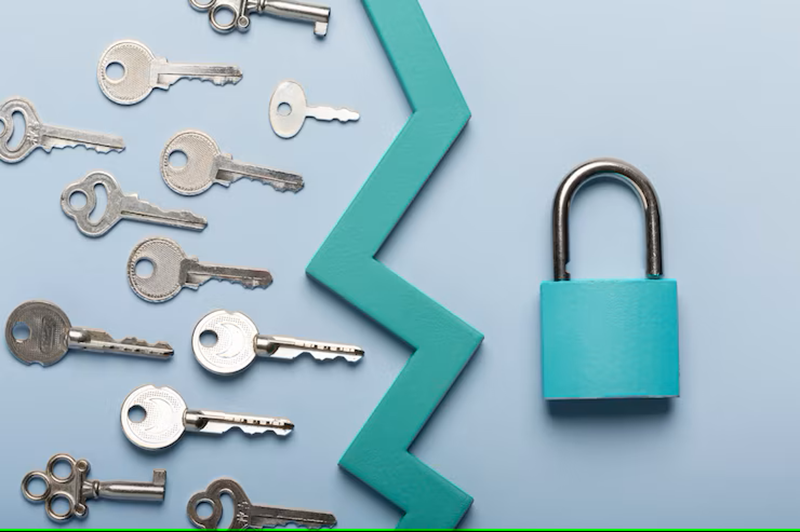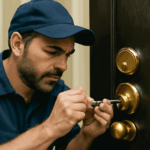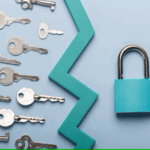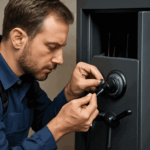Finding mystery keys around your home, office, or inherited from family members is a common experience affecting millions yearly. Coming across a mystery key in a drawer, purchasing a lot with unknown keys, or inheriting a collection without labels makes it useful and important to figure out what each key unlocks to ensure security. With the average household containing 8-15 keys, it’s estimated that 30% of homeowners have at least one unidentified key in their possession.
Key Identification Methods
| Method | Best For | Time Required | Success Rate | Cost |
| Visual inspection & markings | All key types | 5-10 minutes | High for labeled keys | Free |
| Physical comparison | House/office keys | 15-30 minutes | Moderate | Free |
| Professional locksmith | Complex/valuable locks | 1-2 hours | Very high | $50-150 |
| Key cutting shop | Standard keys | 30 minutes | High | $10-30 |
| Digital documentation search | Documented locks | Variable | High if records exist | Free |
How To Find Out What A Key Unlocks?
Before attempting any physical testing, the first step in identifying an unknown key is conducting a thorough visual examination. This initial assessment can provide crucial information about the key’s purpose and origin.
Check for Markings and Numbers
When examining your mystery key, look carefully for manufacturer stamps, serial numbers, or coded markings that can provide clues about the key’s origin and purpose. Most keys manufactured for the market contain identifying information:
Common markings to look for:
- Manufacturer names (Schlage, Kwikset, Yale, Master Lock, Baldwin)
- Numerical codes indicating key blank series
- “DO NOT DUPLICATE” stamps for high-security keys
- Patent numbers or manufacturing dates
- Distributor codes specific to regional suppliers
Key blank identification numbers:
- SC1, SC4 (Schlage residential keys)
- KW1, KW10 (Kwikset house keys)
- Y1, Y11 (Yale lock keys)
- Letters followed by numbers indicating the lock manufacturer series
These markings can immediately narrow down what type of lock the key operates and where it might be used in your property.
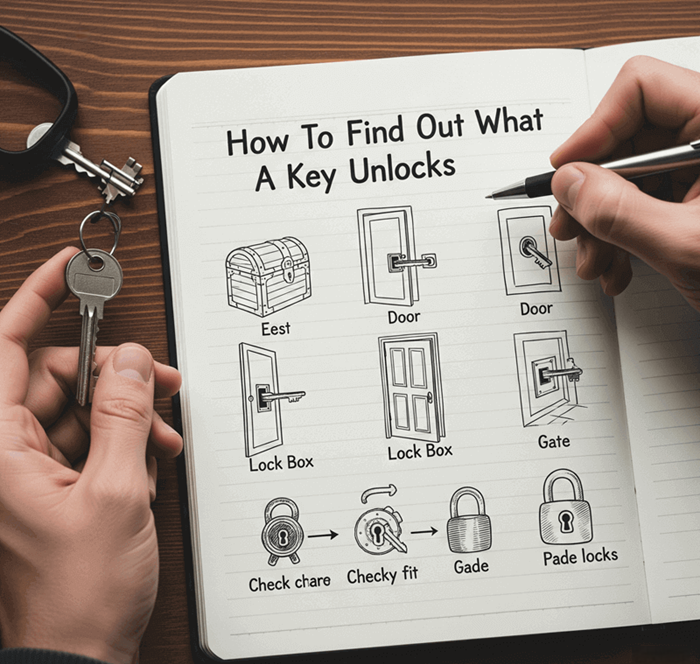
Identify Key Type and Style
Different key shapes and styles correspond to specific types of locks used throughout homes and businesses. Understanding these distinctions helps determine what a key unlocks:
Residential house keys typically feature:
- Brass or nickel-plated construction
- Standard length of 2.5-3.5 inches
- Teeth cut on one or both edges
- Round, oval, or decorative head designs
- Single or double-sided cutting patterns
Specialty key characteristics:
- Padlock keys: Shorter length, simple tooth patterns, often made from cheaper metals
- File cabinet keys: Smaller size with fine, precise tooth patterns
- Deadbolt keys: Longer with deeper, more complex tooth cuts
- Window lock keys: Small, often with unique head shapes
- Mailbox keys: Government-issued with specific USPS markings
Systematic Physical Testing Methods
Once you’ve examined the key visually, systematic testing becomes your next approach to identify what lock it opens.
Start with Obvious Locations
Begin your identification process by testing the most logical locations where the key might belong. This targeted approach saves time and increases your success rate:
Primary testing sequence:
- Main entry doors (front, back, side entrances)
- Interior doors in frequently used rooms
- Exterior storage areas (sheds, garages)
- Basement or attic access points
- Less commonly used interior spaces
Work systematically through your property, testing each lock carefully without forcing the key. Many homeowners find their mystery keys belong to doors they rarely use, such as basement workshops, spare bedroom closets, or seasonal storage areas.
Test House and Office Locks Throughout Your Property
When testing house and office locks, maintain a methodical approach to ensure you don’t miss potential matches:
Exterior lock testing:
- Front door deadbolt and doorknob
- Back door entry systems
- Side or service entrance locks
- Sliding door security mechanisms
- Window locks with key operation
- Garage door manual locks
Interior lock examination:
- Bedroom door privacy locks
- Bathroom door mechanisms
- Home office or study room locks
- Pantry or storage room access
- Built-in cabinet security systems
Remember that some homes use different key systems for deadbolts versus doorknob locks, so test both components on each door.
Check Furniture and Storage Items
Don’t overlook lockable furniture and storage items when trying to determine what a key unlocks. Many households contain numerous secured storage pieces:
Common lockable household items:
- Filing cabinets (home office, basement storage)
- Desk drawers with integrated locks
- Jewelry boxes and armoires
- Gun safes and security lockboxes
- Medicine cabinets and liquor storage
- Toolboxes and workshop equipment storage
- Antique furniture with original locks
Test these items gently, as vintage or specialty locks can be damaged by incorrect keys or excessive force.
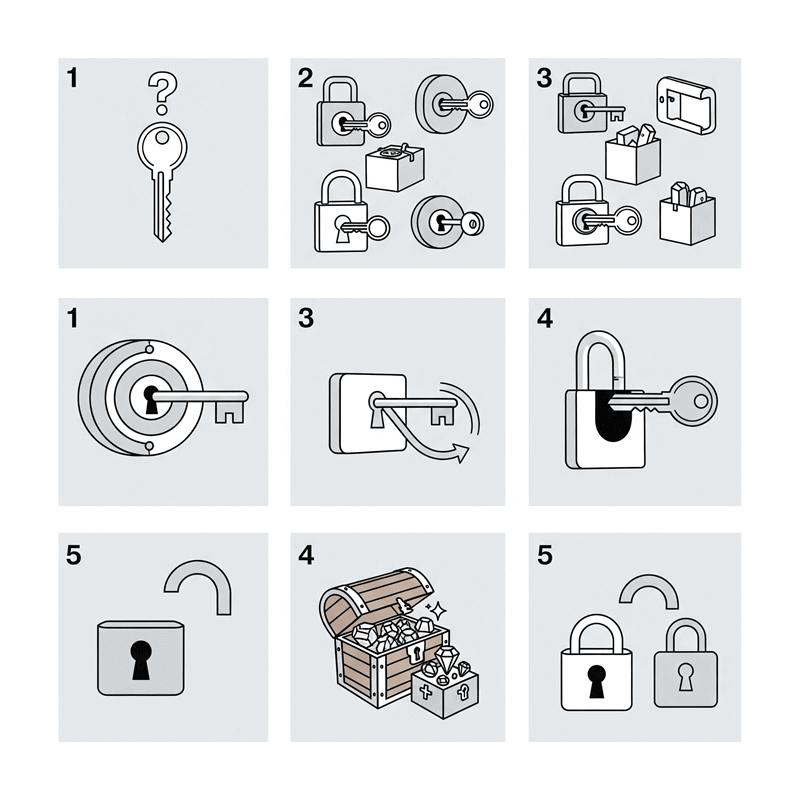
Professional Methods To Find Out What A Key Unlocks
When DIY identification methods aren’t successful, professional services throughout the United States can provide expert assistance.
Consult a Professional Locksmith
Licensed locksmiths represent the most reliable professional resource for identifying mystery keys. These experts have extensive experience with various lock types:
Locksmith identification services:
- Immediate visual identification of common key types
- Access to comprehensive manufacturer databases
- Records of previously installed or serviced locks in your area
- Professional recommendations for security upgrades
- Key duplication services once identification is complete
When to consult a locksmith:
- High-security or restricted access keys
- Antique or unusual key designs from older homes
- Keys that appear valuable or control important access points
- Commercial or industrial key identification needs
Professional locksmith consultation for key identification typically costs $50-150, depending on your location and the complexity of the identification process. Major metropolitan areas like New York, Los Angeles, and Chicago may have higher rates.
Visit Key Cutting Services and Hardware Stores
Local hardware stores and key-cutting shops found throughout communities offer another professional resource for key identification:
Services available at key shops:
- Visual identification of standard residential keys
- Access to key blank reference guides and catalogs
- Potential tracing of key origins through regional distributors
- Recommendations for lock replacement if identification fails
- Key duplication once the lock is identified
Best candidates for hardware store identification:
- Standard Kwikset, Schlage, or Yale residential keys
- Common padlock keys from major manufacturers
- Older vehicle keys (pre-electronic models)
- Standard commercial building access keys
The cost for professional key identification at cutting services ranges from $10 to $ 30, making this an affordable first step before consulting a locksmith.
Documentation and Record Keeping Strategies
Before abandoning identification efforts, explore existing documentation that might contain information about locks and keys in your property.
Search Property Records and Documentation
Property-related documents often contain valuable information about security systems and locks installed by previous owners or contractors:
Essential documents to review:
- Home inspection reports from purchase or recent evaluations
- Previous owner disclosure statements and transfer documents
- Property management records (if applicable)
- Contractor receipts for door, window, or security work
- Home warranty documentation listing covered locks
- Real estate listing photos showing lock types
Pay special attention to any security system installations, lock replacements, or door/window upgrades documented in these records.
Review Insurance and Security System Documents
Insurance policies and security documentation frequently list installed locks and their specifications:
Key documents to examine:
- Homeowner’s insurance policy schedules and inventories
- Security system installation and monitoring agreements
- Alarm system user manuals and key logs
- Safe or vault documentation with key inventories
- Previous insurance claims related to security or lockouts
Many insurance companies require detailed inventories of security features, which may include specific lock models, key quantities, and access control information.
Safety and Legal Considerations
When attempting to identify mystery keys, consider both the safety and legal implications of your testing activities.
Verify Ownership Rights and Access Permissions
Before testing keys on locks, especially in shared living situations or rental properties, ensure you have legitimate access rights:
Situations requiring extra caution:
- Apartment buildings with shared common areas or facilities
- Rental properties where you’re a tenant rather than the owner
- Workplace locations with restricted or controlled access
- Properties with multiple owners, tenants, or residents
- Condominium or HOA-controlled areas
Always verify permission to test locks, particularly in areas that might be considered private, restricted, or belonging to other parties.
Security Implications of Unidentified Keys
Unidentified keys represent potential security vulnerabilities that require careful consideration:
Security concerns to address:
- Unknown keys could provide unauthorized access to your property
- Missing or unaccounted keys may indicate compromised security systems
- Mystery keys might belong to outdated or bypassed security measures
- Unidentified keys could access valuable storage areas or safes
Consider the potential risks of leaving locks accessible to unknown keys versus the cost and inconvenience of changing locks or security systems.
When to Give Up and Replace Locks
Sometimes, the most practical and secure solution is to abandon identification efforts and replace locks instead.
Cost-Benefit Analysis for Lock Replacement
Compare the financial practicality of continued identification efforts versus lock replacement:
Factors to consider in your analysis:
- Time already invested in identification attempts
- Professional service costs for extensive identification
- Potential security risks of leaving unknown keys unidentified
- Cost of new locks and professional installation
- Value of items protected by mystery locks
In many cases, especially for standard residential locks, replacement costs ($40-120 per lock, including installation) may be comparable to extensive professional identification services.
Security Priorities and Risk Assessment
When security concerns outweigh identification costs, lock replacement often provides the best peace of mind:
Situations favoring replacement over continued identification:
- Recently purchased homes with unknown key history
- Properties where previous tenants, owners, or contractors had key access
- High-value items or areas protected by unidentified locks
- Commercial properties with specific security requirements
- Locations where security breaches could have serious consequences
Remember that new locks come with known key quantities, can be re-keyed to match existing systems, and provide documented security control.
Conclusion
Learning how to find out what a key unlocks requires a systematic approach that combines careful visual inspection, logical testing methods, and professional consultation when necessary. While not every key mystery can be solved, following the methods outlined in this comprehensive guide will help you identify most mystery keys efficiently and safely.
Start with free methods like visual inspection and systematic testing throughout your property, then progress to professional services if needed. Always consider the security implications of unidentified keys and don’t hesitate to replace locks when identification proves difficult, costly, or potentially compromising your security.

